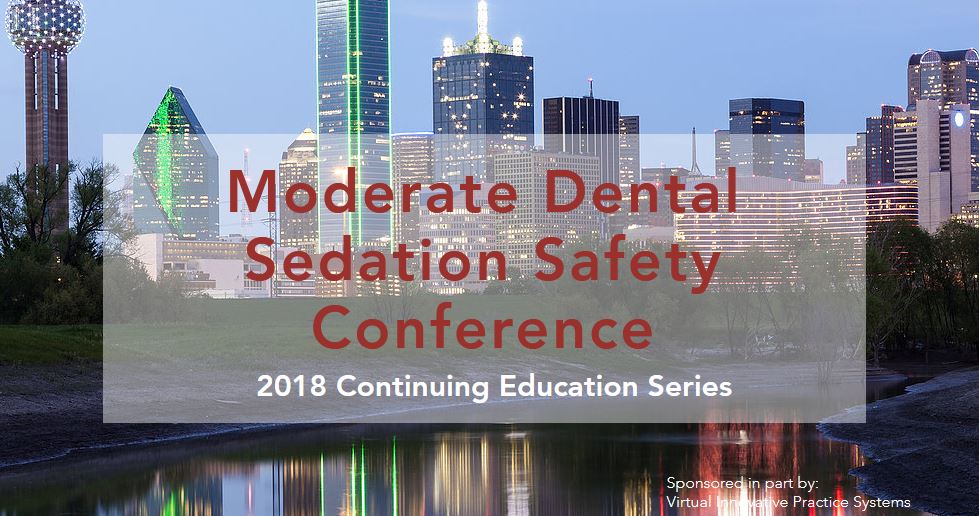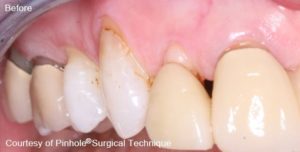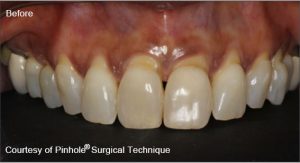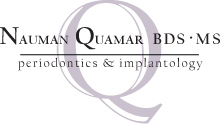VIPS Dental
Moderate Sedation Safety Conference 2018
March 28, 2018
Don’t Miss Out on Valuable News, Information and Education About the Changing Rules and Guidelines for Office Anesthesia.
- Equip yourself with the appropriate emergency equipment/drugs and the appropriate response skills
- Understand the differences and restrictions for higher risk patients such as ASA 3&4 and Pediatric patients as it relates to sedation
- Overview of the new requirements, restrictions and special designations required for anesthesia permitting and practice in Texas
- Protect yourself from liabilities related to sedation practice
- Improve your safe practice of minimal and moderate sedation in your dental practice

8 Hours Continuing Education Credit
This course provides 8 hours of Continuing Dental Education in AGD Subject Code 342.
Approved PACE Program Provider FAGD/MAGD. Credit Approval does not imply acceptance by a state or provincial board of dentistry or AGD endorsement. 5/1/16 through 4/30/20
Date: June 1, 2018
Time: 7:30a.m.-5:00p.m.
Location: Medical City Dallas; City Hall Auditorium Dallas, TX
Attend Live or Via Webinar:
For Webinar Registration go to: www.txsedationed.com and click the link for webinar registration.
For Live Attendance register online at www.txsedationed.com or complete the registration form to the right and fax to 972-239-9507.
World-Class Speakers
- Dru Riddle, PhD, DNP, CRNA
- Reena Kuba, DDS
- Shawn Seifikar, DDS
- Bryan Moore, DDS
- David L Roberts, DDS
- Joe Loiacano, JD
Speaker Bios: www.txsedationed.com
This year, we have assembled a diverse panel of experts to provide instruction on areas of special concern to sedation providers. We will receive the unique perspectives of various specialties including medical anesthetists, dental anesthesiologists, pediatric dentists as well as general dentist anesthesia providers.
We will also learn about practical risk management from attorney Joe Loiacono, JD of the Loiacono Law Group.
Special Session: TSBDE Rule Update
Qualified authorities on the recent changes and updates to the rules governing anesthesia in Texas will present an update. Stay tuned to the website for the announcement of the special session speakers.
Download Course Brochure Here: 2018 sedation course flyer
Dental Insurance Updates for 2018
December 7, 2017
 Every year around this time, we anticipate dental insurance updates and plan changes for the coming year. The dental insurance world is constantly changing. Coverage requirements, restrictions, criteria and procedure codes change as often as the weather. Over the past few weeks, rumors about changes to dental insurance plans have been plentiful. The administrative team at VIPS Dental works hard to pinpoint accurate and reliable information about insurance plans in the areas where our services are affected. Our goal is to make sure our clients have a plan to roll with the punches when it comes to securing the maximum reimbursements for their patients.
Every year around this time, we anticipate dental insurance updates and plan changes for the coming year. The dental insurance world is constantly changing. Coverage requirements, restrictions, criteria and procedure codes change as often as the weather. Over the past few weeks, rumors about changes to dental insurance plans have been plentiful. The administrative team at VIPS Dental works hard to pinpoint accurate and reliable information about insurance plans in the areas where our services are affected. Our goal is to make sure our clients have a plan to roll with the punches when it comes to securing the maximum reimbursements for their patients.
Including surgical services in your general dental practice should be simple, predictable, and stress-free. Providing your patients with expanded treatment options makes dental care more convenient, more comfortable and increases patient follow-through on needed treatment. Our administrative team and Insurance Help Desk work hard to help you give your patients more of what they expect from their dentist.
New CDT Codes for 2018
The CDT table has been updated for 2018, and several codes have been deleted while several more have been added. One that affects our clients and patients in particular is the way moderate iv sedation will be reported. Beginning January 1, 2018, moderate sedation should be reported using CDT code D9239 for the first 15 minutes of moderate iv sedation and code D9243 for each additional 15 minutes of iv moderate sedation. Please be sure to make this change to your system, and use the new code when verifying dental benefits.
Increasing Popularity of EPO Plans
We expect to see an increase in the popularity of EPO (Exclusive Provider Organization) dental plans. EPO dental plans function similarly to PPO dental plans in covered services, deductibles and annual maximums, with one very important exception- there are no benefits payable to out-of-network providers. Be mindful of your patients’ plan TYPE (PPO, DMO, EPO) and verify coverage appropriately to prevent financial surprises for your patients. If you are not a participating provider for an EPO plan, and you file a claim for services, it WILL NOT BE PAID by the plan. If you are in Texas, EPO plans will be less popular and limited to Federal Employees.
Tips for Dental Insurance Success
We want patients to take advantage of the full provisions of their dental plan to assist in the cost of convenient, compassionate quality dental care within the dental practice of the doctor they know and trust. In order to maximize the dental plan contribution, and minimize financial ‘surprises’ for patients, we recommend that every patient’s plan benefits and plan type are verified prior to treatment. Send a pre-determination of benefits request for all patients, whenever possible. Make sure your claims are populating with the correct information in the appropriate fields in order to ensure accurate claims processing.
Learn More About In-House Surgery and Specialty Care
Are you an exceptional dental practice? Would you like to learn more about offering your patient more of the services they want and expect in your practice? Want to know more about the ways VIPS supports your team when working with a mobile surgical provider? Contact Us for a free consultation and assessment to get linked to a provider in your area.
Stop “Watching” Gum Recession!
May 9, 2017
Please stop me if you’ve seen this story unfold before. Your patient comes in for a cleaning and exam. Their teeth are sensitive, so your hygienist

Don’t “Watch” This
takes special care to avoid the exposed root around #’s 19 and 20. Recession.
Last year, you prescribed fluoride trays to help relieve the sensitivity. You don’t know if they are using the trays, however, because you can’t recall the last time you authorized a refill on the gel.
The exposed root causes the patient to jump out of the chair at the slightest contact with room temperature irrigation water or (gasp!) the scaler. You come in for your exam and note gum recession, which has deepened by .5mm since last year. There’s no active periodontal disease or infection, the recession seems to be caused by parafunctional habits. You consider prescribing a nightguard.
“Let’s keep watching this area on the lower left here. You have a little bit of gum recession going on there. That’s why those teeth are so sensitive”.
The Gum Recession is Not Going to Improve- It’s Going to Get Worse
“Let’s keep watching this area on the lower left here. You have a little bit of gum recession going on there. That’s why those teeth are so sensitive”. You’ve been watching the recession for 2 years, but the gum tissue is never going to grow back. Your hygienist, kind as she is, laments having to be so careful around those teeth, which could really use some scaling, but your poor patient deals with pain and sensitivity on a daily basis.
Why do you continue to “watch” this area? Would you “watch” the area if it was a small occlusal decay?
50% of Your Patients Will Develop Some Form of Gum Disease
It’s no exaggeration that about half of all your patients have or will have some form of gum disease, and that figure jumps to 70% for patients over age 65. Are you “watching” gum recession in 50% of your patients, waiting for it to progress to a serious problem? What about 25% of your patients?
Early intervention is the key to preventing tooth loss from recession. As time marches on, the alveolar bone continues to deteriorate, bringing the gum tissue down with it. Not only can correction of recession provide an aesthetic improvement, but it can also prevent further bone loss and eventual tooth loss.
Combined with correcting the cause of the recession, state of the art techniques, such as the Chao Pinhole Surgical Technique are minimally invasive with no downtime. This treatment provides dramatic results that can help your patients keep their natural teeth longer, relieve sensitivity from exposed root surface, and improve appearance. For more advanced bone loss, grafting and regeneration of alveolar tissues may help reverse the damaging effects.
Chao Pinhole Surgical Technique

Pinhole Technique Corrects Gum Recession Without Down Time
Treating recession before it becomes a serious problem is key to maintaining strong, healthy teeth for a lifetime. Give Dr. Q a call, and let’s schedule a Lunch & Learn to provide you and your team with important tools to help do the right thing for more patients with recession.
Pinhole ® Surgical Technique in DFW Corrects Gum Recession Instantly
February 16, 2017

Gum Recession, Before Pinhole
A Breakthrough Treatment for Gum Recession
Now available in Your DFW Dental Practice: Offer Your Patients the Pinhole Surgical Technique
Scalpel-Free, Suture-Free, Conventional Graft- Free
What is gum recession?
Why should gum recession be taken seriously?
What is the Chao Pinhole ® Surgical Technique (PST)?

Correcting Gum Recession With Pinhole Surgical Technique
How Does PST Differ From Traditional Grafting?

Conventional Gum Grafting
How is PST performed?
What are the benefits of PST?
Register for Sedation CE- Medical Evaluation and Patient Monitoring in Moderate Sedation
January 5, 2017
Continuing Education for Moderate Sedation
If you are dentist who holds a Level 2 or Level 3 Sedation Permit in Texas, you will be interested in attending this informative one-day course on February 3, 2017 in Dallas, TX. Dr. Daniel E. Becker, a nationally respected leader in dental anesthesia/sedation education is the featured educator on Medical Evaluation and Patient Monitoring. In addition to a quality educational opportunity, the day’s events also include a commentary about the American Dental Association’s recent adoption of Resolution 37, a guideline which requires the use of capnography in moderately sedated patients, so you will know what changes are taking place, and how it might affect your dental practice. The afternoon session will include an expert panel discussion on morbidity and mortality, with an emphasis on recent developments within the State of Texas.
 Daniel E. Becker, DDS
Daniel E. Becker, DDS
Dr. Becker received a BS in Zoology at Ohio University in 1968 and his DDS from Ohio State University in 1972. He is currently Associate Director of Education for the General Practice Dental Residency at Miami Valley Hospital in Dayton, Ohio. In addition to his academic responsibilities, Dr. Becker provides IV sedation services for dental practices throughout the Dayton area and has published numerous articles in scientific journals and textbooks. He lectures extensively for dental organizations, colleges and universities on topics related to pharmacology, sedation and anesthesia, medical assessment and medical emergencies. Dr. Becker is noted for his pragmatism and his ability to convert otherwise “dry” material into formats that are both entertaining and informative.
 Bryan T. Moore, DDS
Bryan T. Moore, DDS
A Dallas native, Dr. Moore received his Bachelor of Arts degree from The University of Texas at Austin and his Doctor of Dental Surgery degree from Baylor College of Dentistry. He then continued his training with an additional year in a general practice residency at The University of Texas Health Science Center in San Antonio. During his residency he received advanced training in dental and implant surgery, as well as sedation procedures.
Dr. Moore is an active member of several dental associations and currently serves as a Director in the Texas Academy of General Dentistry and is a Representative on the Anesthesia Committee in the ADA Council for Dental Education and Licensure.
Why Attend This Course?
If you are a provider of Sedation in Texas, then you are most likely aware that the practice of moderate sedation is changing. As a conscientious provider, you want to not only stay current with changes in the ADA Guidelines and State Regulations, you are motivated to never stop learning in order to continually provide your patients with the safest, most dependable care you can provide.
Dr. Dan Becker is renowned for his no-nonsense approach, practical subject matter and entertaining educational style. The objective of this course is to increase safe practice of office based anesthesia through expert and appropriate patient assessment and monitoring techniques.
We are bringing world-class Sedation Continuing Education to Texas- Don’t Miss Out.
Course Information
Date: 2/3/17
CE Hours: 8
Time: 7:30AM- 4:00PM
Location: Medical City Dallas-City Hall Auditorium
7777 Forest Lane
Care Tower E, 2nd Floor
Dallas, TX 75230
Registration Info
Click here to register for this course.
AGD Provider # 369052



